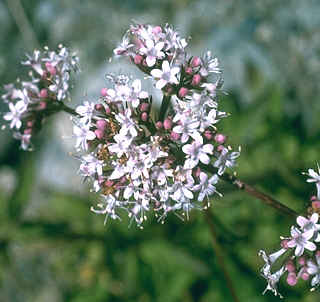
Plant Description
Caution & Interaction

Latin (botanical) name:
Valeriana officinalis
Common names: Phu (Galen), All-Heal, Great Wild Valerian, Amantilla, Setwall, Setewale Capon's Tail, Set-Well, English Valerian, Belgian Valerian, Common Valerian, German Valerian, Heliotrope, Garden Heliotrope, Fragrant Valerian, Vandal Root, Amantilla, Capon's Tail
Plant Description: Valerian is a common perennial root found in moist situations throughout Europe and north to the Arctic Circle; however, it can also be found in dry, elevated ground. Found further south, the plants are generally smaller with narrower leaves. Valerian grows to be about 3-4 feet tall. The roots merge into a short, conical root-stock or erect rhizome. The rootstock is short, giving off a tuft of long creeping runners. Its erect, fluted stem shoots out from the root. The leaves of the Valerian are pinnate with 7-21 lanceolate segments somewhat serrated and slightly hairy. The leaves are more infrequent and opposite higher up the stem. Leaflets are generally from six to 10 pairs and usually 2-3 inches long. The upper surface has strong veins, while the underneath is a pale green covered with short, soft hairs. Valerian blooms from June to September with tubular, funnel-shaped flowers with five equal lobes. They are a soft pink or white tinged with pink color. The fruit of Valerian is a capsule containing one oblong seed.
Medicinal Properties &Uses: The chief constituent of Valerian is a yellowish-green to brownish-yellow oil, present in the dried root. The quantity of oil varies because of locality--plants found in dry, stony soil yields a root richer in oil than those found in moist lands. Because Valerian is considered nervine, stimulant, carminative, and anti-spasmodic, it has a powerful effect on the cerebro-spinal system. It alleviates pain and helps promote sleep, but leaves no unpleasant aftereffects. It is especially beneficial to patients suffering from nervous disorders, such as hysteria and excitability. Additionally, Valerian has proven to be effective in treating migraine, rheumatic pains, dysmenorrhoea, and intestinal colic.
Dosage: 20-40 drops in water or juice, 2-3 times daily or as needed. Shake well before using.
Cautions & Interactions: Keep out of reach of children.
Efficacy Studies & Other Clinical Data:
Disclaimer (U.S. Only): These statements have not been evaluated by the FDA. These products are not intended to diagnose, cure, treat, or prevent any disease.
Common names: Phu (Galen), All-Heal, Great Wild Valerian, Amantilla, Setwall, Setewale Capon's Tail, Set-Well, English Valerian, Belgian Valerian, Common Valerian, German Valerian, Heliotrope, Garden Heliotrope, Fragrant Valerian, Vandal Root, Amantilla, Capon's Tail
Plant Description: Valerian is a common perennial root found in moist situations throughout Europe and north to the Arctic Circle; however, it can also be found in dry, elevated ground. Found further south, the plants are generally smaller with narrower leaves. Valerian grows to be about 3-4 feet tall. The roots merge into a short, conical root-stock or erect rhizome. The rootstock is short, giving off a tuft of long creeping runners. Its erect, fluted stem shoots out from the root. The leaves of the Valerian are pinnate with 7-21 lanceolate segments somewhat serrated and slightly hairy. The leaves are more infrequent and opposite higher up the stem. Leaflets are generally from six to 10 pairs and usually 2-3 inches long. The upper surface has strong veins, while the underneath is a pale green covered with short, soft hairs. Valerian blooms from June to September with tubular, funnel-shaped flowers with five equal lobes. They are a soft pink or white tinged with pink color. The fruit of Valerian is a capsule containing one oblong seed.
Medicinal Properties &Uses: The chief constituent of Valerian is a yellowish-green to brownish-yellow oil, present in the dried root. The quantity of oil varies because of locality--plants found in dry, stony soil yields a root richer in oil than those found in moist lands. Because Valerian is considered nervine, stimulant, carminative, and anti-spasmodic, it has a powerful effect on the cerebro-spinal system. It alleviates pain and helps promote sleep, but leaves no unpleasant aftereffects. It is especially beneficial to patients suffering from nervous disorders, such as hysteria and excitability. Additionally, Valerian has proven to be effective in treating migraine, rheumatic pains, dysmenorrhoea, and intestinal colic.
Dosage: 20-40 drops in water or juice, 2-3 times daily or as needed. Shake well before using.
Cautions & Interactions: Keep out of reach of children.
Efficacy Studies & Other Clinical Data:
-
Clinical Studies Valerian Root
-
Forschung Kommite Clinical Studies on Valerian
-
American Health Consultants - Valerian Root for Insomnia
-
"Comparative study for assessing quality of life of patients with exogenous
sleep disorders treated with a hops-valarian preparation and a benzodiazepine drug"
Disclaimer (U.S. Only): These statements have not been evaluated by the FDA. These products are not intended to diagnose, cure, treat, or prevent any disease.